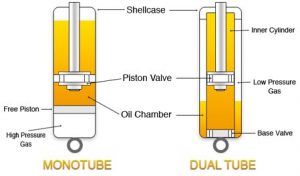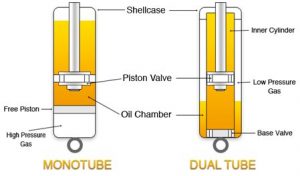Monotube Vs Twin-Tube – What is the Difference? What is Better?
There are many rumors and discussions regarding which type of shock absorber is better, the Mono-tube or the Twin-tube? Mono-tube and twin-tube are known as two different types of suspension systems that each work in very different ways.
Mono-Tube
In a mono-tube shock absorber, the shocks components are contained within one tube. A mono-tube system contains a shell case which works as a cylinder. Within that cylinder you would find a piston valve, oil, and gas. The construction of a mono-tube does also include some differences compared to the twin-tube design. A mono-tube design utilizes a free piston which separates the oil chamber from the gas chamber within the shell case.
Twin-Tube
In a twin-tube shock absorber there are 2 cylinders: 1 cylinder is set inside the shell case, and the second cylinder contains the piston valve which moves up and down within this second cylinder known as the “inner cylinder”. With a twin-tube design, there is no piston or barrier between the oil chamber and gas chamber.
Pros and Cons of Mono-Tube Shock Absorbers
Pros of Mono-Tube

- As temperature increases, oil is able to release heat with less effort.
- Zero restrictions on installation angles.
- Less prone to cavitation
- Larger oil capacity and greater heat dissipation allows for a stable damping force that is continuous.
- Air is not able to penetrate the oil or gas since they are completely separated.
- 100% efficiency through all temps.
- The piston valve is bigger and wider in a mono-tube design which allows for a wider area of pressure. In turn this means the shock can create even a subtle damping force precisely.
Cons of Mono-Tube
- A stiffer ride is expected because an injection of high pressured gas is required in the structural design.
- This high pressured gas can also lead to a higher amount of stress on seals which can cause more friction.
- More expensive to manufacture
- When there is external damage or force on the shell case, that directly affects the inner cylinder.
- Since the oil and gas chambers are positioned next to each other, it is increasingly difficult to maintain sufficient stroke.
- The inverted design has more friction caused from more moving parts.
Pros and Cons of Twin-Tube Shock Absorbers
Pros of Twin-Tube

- Unlike the inverted design, friction can be stopped.
- External damage to the shell case does not effect the shock absorber.
- The twin-tube design provides a superior manufacturing process which keeps the cost of production low.
- Gas pressure is kept low thanks to the base valve, this creates a more comfortable ride.
- Low gas pressure reduces stress on seals and also keeps friction to a minimum.
- Sufficient stroke is attained with far less effort. This is because each oil and gas chamber are separated.
Cons of Twin-Tube
- The construction causes difficulties when installing.
- Aeration is possible since the oil and gas chambers are not separated.
- Size of Piston is greatly decreased compared to the mono-tube design.
- Oil capacity is reduced in comparison to the the mono-tube.
- Low Pressure – Generally very Soft
- Small Pistons, more prone to heat and limited on damping
- CAVITATION- Fluid and gas mix, exponential performance loss up to 35%
- 1 Directional Mounting
All ISC Suspension systems use the mono-tube design for performance purposes along with the fact that the pros of the mono-tube design greatly outweigh it’s cons.
Related Links
Why is it Important to Properly Align Your Suspension?
Monotube Vs Twin-Tube – What is the Difference? What is Better?
What is an Air Cup and How Do they Work?
BMW X-Drive Coilovers & Suspension
ISC Suspension Valving Options: Which One is Right for You?
SWIFT Springs; Optional Upgrade for many ISC Coilovers
Product Feature: ISC 240SX Rear TOE ARM
How to Setup a Drift Car – Proper Drift Settings
Triple S Coilover Springs – Does it Make a Difference?
What is the Best Coilover Ride Height for My Car?
ISC V3.1 Rear Adjustable Control Arms
Upgrades to Consider when Installing Coilovers
Should I install coilovers on my car?
What is the purpose of adjustable end links and how do they relate to my coilovers?
Difference between ISC N1 and Basic, which to choose?
